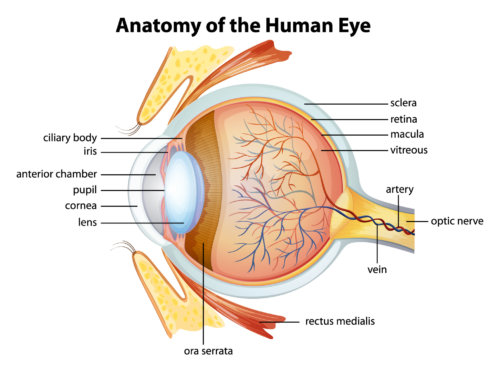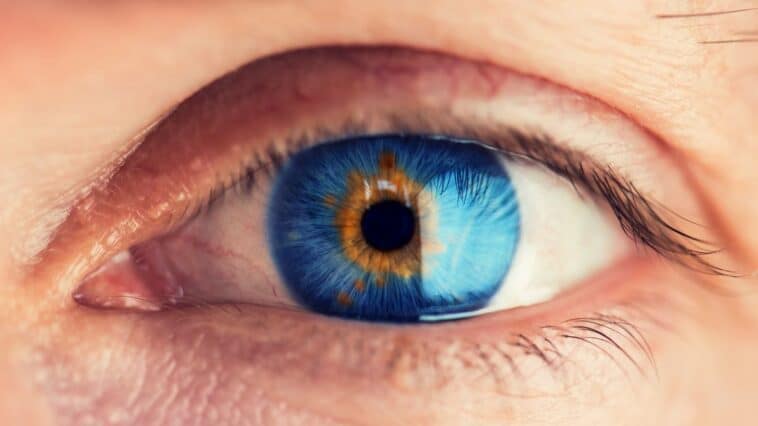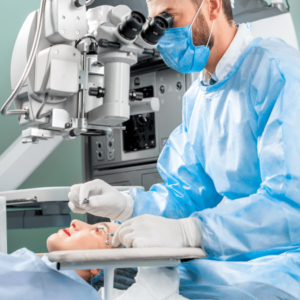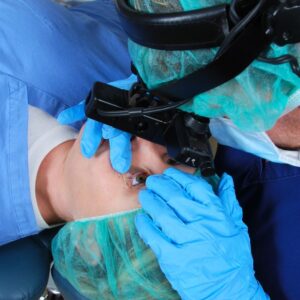The human eye is a complex organ responsible for capturing light and converting it into electrical signals that the brain can interpret as visual images.
The eye is an extraordinary organ composed of external and internal components that work together. Light entering the eye is converted into electrical signals, which are then processed by the brain and interpreted as sight. It’s an incredibly intricate process without which we would not be able to see
Eye Diagram
A detailed look at the Eye Anatomy (parts of eyes) and their functioning will help us understand the vision’s nitty-gritty. Eye Anatomy is a combination of many subtle parts that work together in a disciplined manner to provide the best quality vision to humans.
The eye diagram given below will help us understand the anatomy of the eyes in a picturesque manner.
Eye Anatomy – Vision and Parts

The eye is an amazing organ involved in the perception of light and translating it into images. It is made up of external and internal components. All these parts work together to take in light and turn it into electrical signals that the brain can interpret.
Outer parts of the eye include:
- Cornea: is the transparent dome-shaped tissue that covers the front of your eye. It allows light to enter the eye and helps you focus it so you can see clearly.
- The Sclera, commonly referred to as the white of the eye, is a protective sheath that helps keep the eye’s delicate tissue and structures together. It also serves to give the eye its round shape.
- Iris: – it is the colored part that surrounds the pupil and controls the amount of light that enters the eye. It can range in color from brown or blue to green or gray; some people even have two different colors in each eye. The quantity of pigment in each individual’s iris determines its coloration.
- Pupil: The pupil of the eye is located in the middle of the iris and is a circular opening that allows light to enter the eye. This adjustable opening works like an aperture, adjusting itself wider or smaller depending on the amount of light needed for vision.
- Conjunctiva: a thin protective membrane that lines the eyelids’ inner surface and covers the eye’s white part, or sclera. It is made up of epithelial tissue with some underlying connective tissue, providing lubrication to reduce friction as the eyelids move.
Internal parts of the eye include:
- Lens: The lens, located behind the eye’s iris, is vital in ensuring that light enters the eye and is focused correctly.
- Retina: a thin layer of tissue located at the back of the eye. The cells in the retina, called rods and cones, are responsible for converting light into electrical signals, which can then be processed by the brain and interpreted as vision.
- Optic Nerve: this is an integral component of this system, as it connects the retina to the brain, carrying electrical signals from the light-sensitive cells to be interpreted by the brain into visual stimuli. This nerve comprises bundles of nerves that relay information to the brain so we can comprehend our surroundings.
- Choroid: The choroid is part of the eye’s anatomy. It consists of a layer of blood vessels located between the outer and inner layers of the eye. Its primary function is to deliver oxygen and nutrients to the retina, which helps maintain healthy vision.
Our eyes are miraculous organs that allow us to take in and experience the world. The retina plays a key role in making this possible. It comprises more than 120 million rods and 6 million cones that enable us to perceive shapes, fine details, and vibrant colors.
Rods detect light and allow our vision in low-light settings, while cones discern between different shades of color when brightness is higher.
In summary, the eye is an incredible human body feature that allows us to see beauty in the world. It contains a complex network of components designed to convert light into images our brains can understand. From the outermost layer of the eye, responsible for its color, to the innermost structures, which allow us to observe details and colors, each part works perfectly together to give us this remarkably intricate sense.
How does The Eye work?
The eye is a complex organ that converts light into electrical signals that the brain can interpret as images. The process starts when light enters the eye through the cornea, the eye’s clear outer covering. The cornea helps to focus incoming light and protects the eye from dust and other particles.
The eye is an organ of the body that detects and receives light. Light passes through the iris, the colored part of the eye that encircles the pupil. The iris is responsible for controlling how much light gets into the eye’s pupil, a round opening in the center of the iris that is adjustable in size.
Light enters the eye and passes through the cornea, a transparent membrane covering the front of the eye that helps to focus the light.
Then, it moves on to the lens, which further focuses it before finally reaching the retina at the back of the eye. The retina contains rods and cones.
The eye uses both rods and cones for visual perception. Rods are located all over the retina and are highly sensitive to light. They allow us to perceive shapes and movement in the dark but can not distinguish colors. Cones are located primarily in the macula, which is in the retina’s center, enabling us to see the color under bright light conditions.
The rods and cones in the retina act as photoreceptors, converting light into electrical signals sent to the brain via the optic nerve. In the brain, these signals are then interpreted by the visual cortex to create an image we can understand.
Eye Conditions
Many eye conditions can affect a person’s vision and overall health. Some common examples include:
- Myopia (nearsightedness) is a common eye condition in which distant objects appear blurred. This can be attributed to the eyeball being too long or the cornea having too much curvature. Individuals with myopia may seek treatment through corrective lenses, glasses, and refractive surgery.
- Hyperopia(farsightedness) is a vision condition that affects the shape of the eye. It is typically caused by either an eyeball that is too short or a cornea that is too flat. People with hyperopia can see distant objects clearly but have difficulty focusing on up-close items. Fortunately, this eye condition can be corrected with glasses, contact lenses, or refractive surgery.
- Astigmatism occurs when the curved surface of the cornea (or, in some cases, the lens) is irregularly shaped, causing blurry vision at all distances. Treatment for astigmatism may include eyeglasses, contact lenses, or surgery to correct its effects.
- Presbyopia is an age-related condition affecting the eye’s ability to focus on objects close up. It happens when the lens of the eye becomes less flexible and cannot adjust its shape when looking at nearby objects. Reading glasses, bifocals, or progressive lenses are often prescribed to correct this condition.
- Cataracts this condition causes the lens to become cloudy, resulting in blurry vision, light sensitivity, and glare. Surgery is almost always recommended as the best treatment option for cataracts, involving removing and replacing the cloudy lens with a new one.
- Glaucoma affects the optic nerve, the pathway responsible for carrying visual information from the eye to the brain. It is typically caused by increased pressure within the eye and can be treated with medication, laser surgery, or conventional surgery.
- Age-related macular degeneration (AMD)is a condition that damages the retinal cells in this area and can cause significant vision loss over time. Though there is no cure for AMD, treatments are available that may help slow down its progress and preserve any remaining sight.
- Retinitis pigmentosa (RP) is an eye disorder that affects the retina, leading to progressive vision loss. Symptoms of RP often begin with night blindness and peripheral field loss, eventually resulting in total blindness if left untreated. Unfortunately, there is no cure for this condition; treatments and therapies are available to slow its progression.
The eyes are delicate organs, and it is essential to check them regularly to ensure they are healthy. Many different eye conditions exist and can be diagnosed and treated by an ophthalmologist. An ophthalmologist should be consulted if any signs of an eye condition appear.
Eye treatment
Treatment for eye conditions can vary depending on the specific condition and its severity. Some common treatments include:
Eyeglasses and contact lenses: Vision can be corrected and improved through the use of eyeglasses and contact lenses, which are typically used to treat conditions such as myopia, hyperopia, and astigmatism. When worn, they help to refract light so images can be seen clearly.
Refractive surgery: Refractive surgery, such as LASIK, PRK, and LASEK, are procedures that change the shape of the cornea to help correct refractive errors caused by nearsightedness or farsightedness. This surgery can reduce or even eliminate a person’s need for contact lenses or eyeglasses.
Medications: Medication is one option for treating eye conditions such as glaucoma, cataracts, and age-related macular degeneration. Eye drops or oral medications can help to reduce intraocular pressure in glaucoma cases, dissolve the clogged lens of cataracts, and slow down the deterioration brought on by age-related macular degeneration.
Laser surgery: When eye conditions such as glaucoma, diabetic retinopathy, and age-related macular degeneration are present, laser surgery may be used to treat them. Laser beams can help reduce internal eye pressure in glaucoma patients, seal off bleeding vessels in those with diabetic retinopathy, and restore diminished vision in people with age-related macular degeneration.
Conventional surgery: Cataract surgery is one of the most common corrective procedures for eye-related problems. It involves removing a clouded natural lens and replacing it with an artificial intraocular lens. This outpatient procedure is one of the most successful and commonly performed surgeries in the world today.
Lifestyle changes: One of the best ways to protect your eyes and improve eye health is to make some lifestyle changes. Eating a healthy diet, quitting smoking, and exercising regularly can all help reduce the risk of developing conditions such as age-related macular degeneration or other eye diseases.
The eye is an incredibly complex and delicate, and it is essential to seek medical advice when there are any issues.
Treatment options may vary depending on the condition and involve a combination of methods. An ophthalmologist can help determine the best course of treatment for a wide range of conditions related to the eye.






